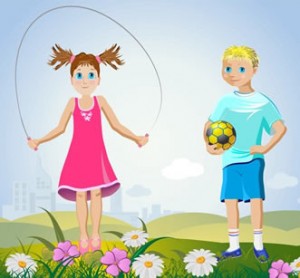By Jacqueline Horsfall
 The preschool group was busily cleaning up blocks, paints, and plastic dinosaurs when I entered the classroom. A hand tugged at my sweater. “Who are you?” asked a curly-headed four-year-old. “I’m the Game Lady,” I said. “We’re going outside and run, jump, and make noise.” She flashed me a big grin. “Oh, yay!” She took my hand and dragged me toward the door leading to the playground area. “C’mon, everybody,” she called to her classmates. “Let’s play games.”
The preschool group was busily cleaning up blocks, paints, and plastic dinosaurs when I entered the classroom. A hand tugged at my sweater. “Who are you?” asked a curly-headed four-year-old. “I’m the Game Lady,” I said. “We’re going outside and run, jump, and make noise.” She flashed me a big grin. “Oh, yay!” She took my hand and dragged me toward the door leading to the playground area. “C’mon, everybody,” she called to her classmates. “Let’s play games.”
It doesn’t take threats or bribery to entice preschool children into physical exercise. But it does require dedicated adults—parents, teachers, babysitters, child care staff—to take an active role at home or school in leading structured games and high-energy activities instead of simply shooing kids outside, saying, “OK now, go find something to do.”
What? you say. Me lead a game? Don’t worry. The best games are the ones that are easy to learn quickly. Freeze Tag. Duck-Duck-Goose. Red Light Green Light. Dodge ball. London Bridge. The test of a winning game comes from young players themselves when they shout, “Let’s play it again!”
Here are a few pointers to help you get your game-on:
1. Be the Game Leader for one game. In subsequent play, any child may become the new Leader or all may take turns being the Leader. That leaves you free to supervise, referee, or become a player by joining the group.
2. Start with warm-ups and end with cool-downs. These bending and stretching exercises focus on joint flexibility, breath work, and coordination—essential to any good workout—but kids see them only as part of the game.
3. Don’t spend a lot of time explaining how the game is played—just play it. Kids catch on quickly once the Leader demonstrates the first time around. Rule #1 is: Rules are made to be broken. If a rule of play doesn’t work, get rid of it and substitute one of your own or ask the players for their suggestions.
4. Be creative. Dream up variations on old favorites. I’ve switched up Tag by incorporating a science lesson, wrapping a child in a gauzy-fabric “cocoon” and unfurling it, letting him/her fly away like a butterfly—with the group chasing after.
5. Keep competition low-key. From my own experience, very young children are more concerned with having a turn, rather than winning.
6. There is no set “play time.” Some games are so much fun, kids beg for repeated play. With a small preschool group, I’ve run three games consecutively to fill a 30-minute time slot. When players tire of one game, begin another.
7. Help children with weak motor skills, but keep it fun and part of the game. Scoop up a child and run to the finish line, nudge a ball in a child’s direction, guide little feet and hands, and give each a turn as Leader.
Bring your enthusiasm and creativity to high-energy group games and instill a love of physical activity in youngsters that will last a lifetime. Start early—with kids as young as 3—and help nip childhood obesity in the bud.
– Jacqueline Horsfall has over 15 years experience in youth-and-family nature programming. She is the author of EarthGames: 50 Nature Games for Ages 3+ – full of chanting “play-it-again” action games that are easy to learn quickly, yet substantial enough to last through repeated play. All games were tested for effectiveness in group play.
